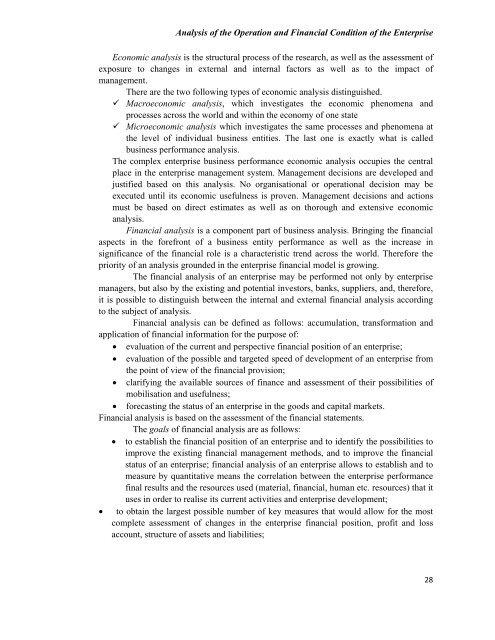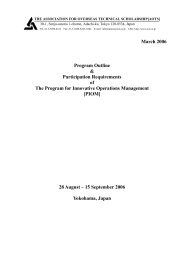Analysis of the Operation and Financial Condition of the Enterprise
Analysis of the Operation and Financial Condition of the Enterprise
Analysis of the Operation and Financial Condition of the Enterprise
Create successful ePaper yourself
Turn your PDF publications into a flip-book with our unique Google optimized e-Paper software.
<strong>Analysis</strong> <strong>of</strong> <strong>the</strong> <strong>Operation</strong> <strong>and</strong> <strong>Financial</strong> <strong>Condition</strong> <strong>of</strong> <strong>the</strong> <strong>Enterprise</strong>Economic analysis is <strong>the</strong> structural process <strong>of</strong> <strong>the</strong> research, as well as <strong>the</strong> assessment <strong>of</strong>exposure to changes in external <strong>and</strong> internal factors as well as to <strong>the</strong> impact <strong>of</strong>management.There are <strong>the</strong> two following types <strong>of</strong> economic analysis distinguished. Macroeconomic analysis, which investigates <strong>the</strong> economic phenomena <strong>and</strong>processes across <strong>the</strong> world <strong>and</strong> within <strong>the</strong> economy <strong>of</strong> one state Microeconomic analysis which investigates <strong>the</strong> same processes <strong>and</strong> phenomena at<strong>the</strong> level <strong>of</strong> individual business entities. The last one is exactly what is calledbusiness performance analysis.The complex enterprise business performance economic analysis occupies <strong>the</strong> centralplace in <strong>the</strong> enterprise management system. Management decisions are developed <strong>and</strong>justified based on this analysis. No organisational or operational decision may beexecuted until its economic usefulness is proven. Management decisions <strong>and</strong> actionsmust be based on direct estimates as well as on thorough <strong>and</strong> extensive economicanalysis.<strong>Financial</strong> analysis is a component part <strong>of</strong> business analysis. Bringing <strong>the</strong> financialaspects in <strong>the</strong> forefront <strong>of</strong> a business entity performance as well as <strong>the</strong> increase insignificance <strong>of</strong> <strong>the</strong> financial role is a characteristic trend across <strong>the</strong> world. Therefore <strong>the</strong>priority <strong>of</strong> an analysis grounded in <strong>the</strong> enterprise financial model is growing.The financial analysis <strong>of</strong> an enterprise may be performed not only by enterprisemanagers, but also by <strong>the</strong> existing <strong>and</strong> potential investors, banks, suppliers, <strong>and</strong>, <strong>the</strong>refore,it is possible to distinguish between <strong>the</strong> internal <strong>and</strong> external financial analysis accordingto <strong>the</strong> subject <strong>of</strong> analysis.<strong>Financial</strong> analysis can be defined as follows: accumulation, transformation <strong>and</strong>application <strong>of</strong> financial information for <strong>the</strong> purpose <strong>of</strong>: evaluation <strong>of</strong> <strong>the</strong> current <strong>and</strong> perspective financial position <strong>of</strong> an enterprise; evaluation <strong>of</strong> <strong>the</strong> possible <strong>and</strong> targeted speed <strong>of</strong> development <strong>of</strong> an enterprise from<strong>the</strong> point <strong>of</strong> view <strong>of</strong> <strong>the</strong> financial provision; clarifying <strong>the</strong> available sources <strong>of</strong> finance <strong>and</strong> assessment <strong>of</strong> <strong>the</strong>ir possibilities <strong>of</strong>mobilisation <strong>and</strong> usefulness; forecasting <strong>the</strong> status <strong>of</strong> an enterprise in <strong>the</strong> goods <strong>and</strong> capital markets.<strong>Financial</strong> analysis is based on <strong>the</strong> assessment <strong>of</strong> <strong>the</strong> financial statements.The goals <strong>of</strong> financial analysis are as follows: to establish <strong>the</strong> financial position <strong>of</strong> an enterprise <strong>and</strong> to identify <strong>the</strong> possibilities toimprove <strong>the</strong> existing financial management methods, <strong>and</strong> to improve <strong>the</strong> financialstatus <strong>of</strong> an enterprise; financial analysis <strong>of</strong> an enterprise allows to establish <strong>and</strong> tomeasure by quantitative means <strong>the</strong> correlation between <strong>the</strong> enterprise performancefinal results <strong>and</strong> <strong>the</strong> resources used (material, financial, human etc. resources) that ituses in order to realise its current activities <strong>and</strong> enterprise development; to obtain <strong>the</strong> largest possible number <strong>of</strong> key measures that would allow for <strong>the</strong> mostcomplete assessment <strong>of</strong> changes in <strong>the</strong> enterprise financial position, pr<strong>of</strong>it <strong>and</strong> lossaccount, structure <strong>of</strong> assets <strong>and</strong> liabilities;28
















